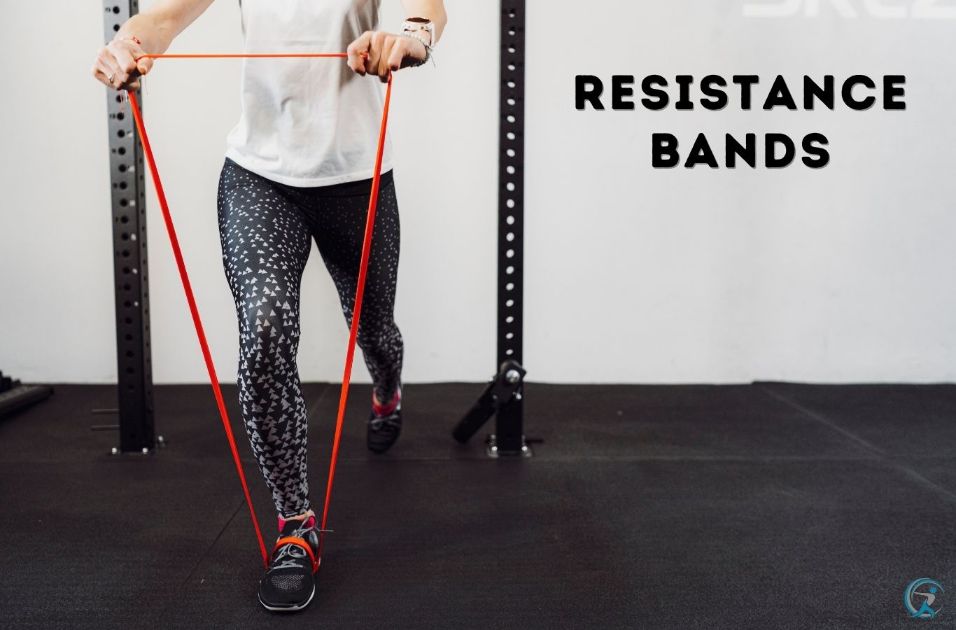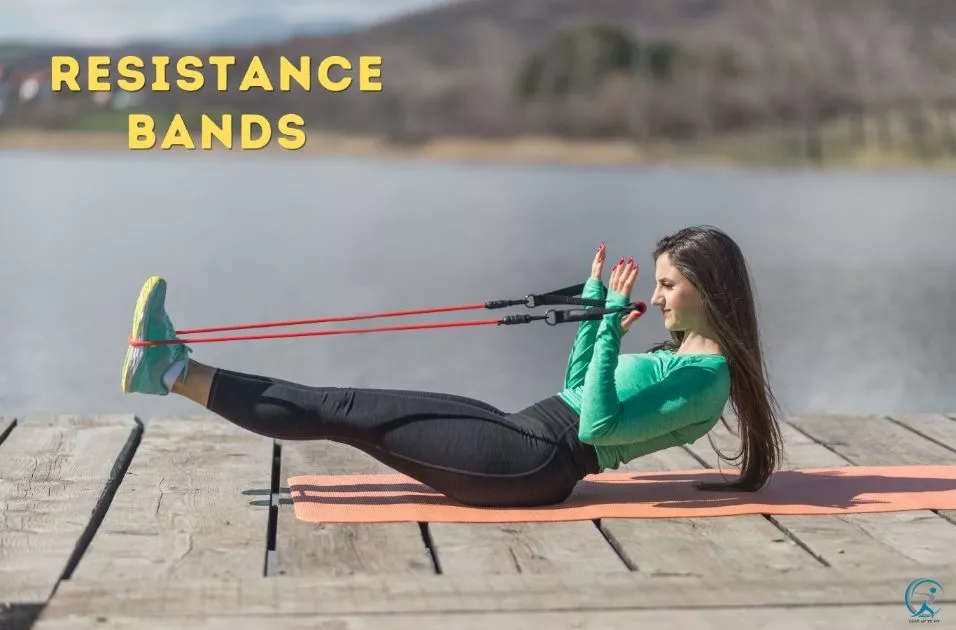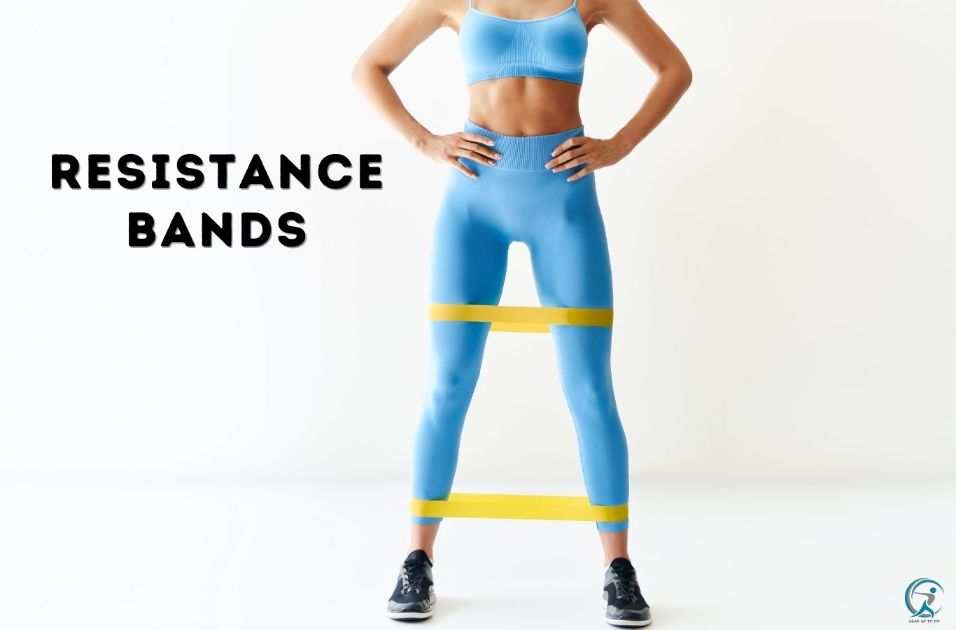In 2026, resistance bands evolve with app-integrated sensors and eco-materials for precise, progressive training. Anchor securely, select variable tension levels, and execute squats, rows, presses—activate full muscle chains for rapid gains anywhere.
⚡ Key Takeaways
- 2026 bands feature Bluetooth sensors tracking reps, form, and calories for data-driven progress.
- Sustainable bio-elastomers offer 2x durability over latex, ideal for intense daily use.
- Variable tension mimics free weights, enabling progressive overload without joint stress.
- App-guided routines personalize workouts, integrating HIIT and mobility for full-body results.
- Hybrid designs combine with dumbbells, boosting versatility for home or travel training.
What are Resistance Bands?
Resistance bands are used for strength training. They are made from rubber tubing and come in various sizes. The resistance band exercises help to strengthen muscles and increase flexibility.
It is one of the best pieces of exercise equipment that can be used at home or the gym.
The main advantage of using a resistance band is that it allows you to perform any workout without going to a gym, even if you have no space for exercise equipment. It also helps burn more calories than other workouts, such as running or cycling. If you want to know how to use resistance bands, read this article.
Types of Bands (Resistance Bands/Exercise Bands/Workout Bands)
There are many types of resistance bands available today. They vary in size, material, and price. Here are some of them:
Stretchy Band
It is very popular among fitness enthusiasts because it has a soft feel and is easy to handle. This kind of band comes with a strap, making it easier to carry around. You can find these kinds of bands online or in your local store.
Elastic Band
These are usually thicker than stretchy ones, and they are good for beginners who do not have much exercise experience.
PVC Band
This kind of band is durable and long-lasting. It is also recommended for people who like to work out at home.
Metal Band
These bands are made from metal and are heavy-duty. They are designed for professional athletes.
Loop Band
These are similar to elastic bands, but they have loops instead of ends. They are useful when you need to attach two different points.
Tube Band
They are made from plastic and are ideal for those who prefer a tight fit. Weight lifters commonly use tube bands.
Therapy Bands
These are typically used to treat injuries. They provide support and stability to injured areas.
Use Resistance Bands for a variety of exercises
If you are new to exercising, you should start with light weights. As you get better, you can gradually add more weight.
- Squats
- Lunges
- Pushups
- Pull-ups
- Tricep dips
- Plank pose
- Lateral raises
- Calf raises
- Leg lifts
- Hip raises
- Shoulder shrugs
- Abdominal crunches
- Crunches
- Knee bends
How do you use them?

1. Use them for strength training
Resistance bands are great tools to build muscle mass and tone your body. They can be used for both upper and lower body workouts. Resistance bands can be used for exercises like push-ups, pull-ups, squats, lunges, situps, planks, and many more.
2. Stretch out your muscles
Stretching helps prevent injuries and keeps your muscles flexible. Stretching can also relieve tension from sore muscles. If you have tight hamstrings or calves, stretching can help loosen them up.
3. Build core strength
Core strength refers to the strength of your abdominal and back muscles. These muscles are responsible for supporting your spine and stabilizing your pelvis. Core strength is necessary to perform basic movements like walking, standing, sitting, and lifting.
4. Improve balance
Balance is essential in preventing falls and injuries. Balance training improves your ability to maintain your center of gravity while moving around. It’s essential to train your core muscles to improve your balance.
5. Increase flexibility
Flexibility is a measure of how much range of motion your joints have. Flexibility increases as you age because it allows your joints to move through their full capacity without causing pain.
6. Reduce stress
Using resistance bands can reduce stress levels by keeping your muscles constantly active. When you do an exercise with resistance bands, you don’t need to concentrate on maintaining your form. This makes the workout easier and less stressful.
7. Enhance sports performance
Sports performance includes endurance, power, speed, coordination, agility, and reaction time. You can enhance these skills using resistance bands. For example, when doing plyometrics (jumping), you can add resistance bands to increase the intensity of your workout.
8. Improve posture
Posture is something that most people take for granted until they feel uncomfortable. Posture problems lead to neck, shoulder, back, knee, hip, ankle, foot, and leg issues. Training with resistance bands can strengthen your core muscles and make you feel better about your posture.
9. Prevent injury
When you lift weights, you risk injuring yourself if you aren’t careful. Using resistance bands can protect your joints by providing support during weightlifting.
10. Make cardio fun!
Using resistance bands can turn your regular cardio into a fun activity. Instead of running on a treadmill or jogging outside, you can stretch and work different body parts at once. Resistance band workouts are easy to modify and perfect for beginners.
11. Workout anywhere
Whether you want to get fit in your living room or on vacation, resistance bands will keep you working hard no matter where you are.
Why Use Resistance Bands?
Resistance bands allow you to get better results without spending hours lifting heavy weights or using expensive gyms. You can use them anywhere, anytime. They’re great for beginners who want to start strength training but don’t properly lift weights.
It’s essential to understand the purpose of resistance bands before buying them.
They are the most effective weight training tool because they allow you to work out at your maximum capacity without injuring yourself.
Athletes use them to strengthen muscles without using heavyweights. They are also used in physical therapy to help patients recover from injuries.
Resistance bands are a new concept for most people because they aren’t used in schools, sports, or gyms. They are harder to use because you have to hold them up while doing exercises. You have to be careful not to let go of the band.
Resistance Band Exercise
Resistance bands are great tools for working out. You can use them to tone up different parts of your body. Try using them to do squats, lunges, push-ups, pull-ups, dips, crunches, planks, etc.
- Your hands should be held up high, with elbows bent.
- Knees should be bent slightly.
- Your back should be flat, and your arms should be straight.
- Try standing on the resistance band, with your hands holding on to the ends.
- It would help if you were doing this exercise every day.
- It helps you get more robust and more flexible.
- Ten reps per exercise.
This exercise is designed to strengthen the muscles of the thighs, glutes, calves, and hamstrings. It also supports the abdomen, back, and neck core muscles.
This exercise is designed to strengthen your core muscles. You should be able to do this exercise without any pain or discomfort.
Resistance band training

Resistance Bands help you burn calories while toning up your muscles. They also help you get rid of fat by working out different body parts. Resistance bands are available in various colors so that you can choose those best suit your workouts.
How To Use Resistance Bands Beginner’s Guide
Resistance bands are great for building muscle mass. You can do many different exercises using them, including chest presses, squats, pull-ups, biceps curls, triceps extensions, and many others.
Beginner Resistance Band Workout
Beginner exercises should be done standing up. Your arms should be outstretched while holding the ends of your resistance band. You should feel the burn when doing these exercises.
Curl your hands to shoulder height and squeeze your biceps while lowering them back down. Do this 10 times. After each set, flutter and kick your leg into the air as high as possible. Then lower your foot back down to the ground. Repeat this 10 times.
Resistance bands are great tools for stretching out muscles. Sit on the floor and loop the handles around both feet. Hold onto the middle of the resistance band with both hands. Lower yourself onto your back. Raise your legs until they’re almost straight up in the air. Then scissor them up and down, one leg at a time. Move slowly and point your toe when doing this exercise.
Complete 10-15 reps for 1 set
Lower your legs so they’re 10 inches off the floor, and do another set of 10 to 15 reps of alternate left and right leg presses. One arm chest press 5 is a great exercise to work the chest muscles and core.
It would help to bend your arm at a 90-degree angle with the palm facing downward.
Squeezing the chest muscles to push your arms out before you and then returning to your starting position is a great exercise to strengthen your legs and glutes. You should be able to do this exercise without any problems.
This exercise is designed to help you gain strength in your legs. Your legs should be straight when you do this exercise. You should feel the burning sensation in your left leg as you move your body to the left. Then repeat the same thing but move your body to the right.
Choosing a resistance band
Bands are great for beginners because they’re easy to use and don’t require any equipment. You can do them anywhere. And since they’re made of elastic material, they won’t break or wear out quickly. In addition, bands are adjustable so you can get more resistance as your body changes over time.
Increase the number of repetitions for each band as you get stronger. Your lower body should be able to move faster than your upper body.
The Benefits of Resistance Bands
Resistance bands are great for building muscle strength. They are easy to use, and they allow you to focus on the exercise rather than worrying about how much weight you’re lifting. If you want to build muscle mass, resistance training is one of the best ways to do it.
Using resistance bands is not more effective than weightlifting. You’ll get the same benefits as weightlifting but also gain additional benefits. They allow you to train more muscle groups and recruit more muscles.
They’re great for building strength for everyday activities like swinging a golf club or lifting your 4-yr-old niece. Resistance bands are great because they’re safe, inexpensive, and simple. You can buy them online or at any sporting goods store. There are many different types of resistance bands. Try some out and see if you like them!
Many people use resistance bands to get strong muscles. They help you work out without any equipment. They are made to be flexible and durable. Using them helps strengthen your arms, shoulders, and lower back.
Your abs also get toned when doing this workout. This exercise targets your entire body by hitting every major muscle group. You’ll get toned abs, shoulders, back, arms, and legs. You’ll also feel the burn in your lower back.
The Pros
You may be wondering why resistance bands are better than other types of exercise equipment. Well, they work as well as any other type of equipment. However, they have a few advantages over regular exercise equipment:
Resistance bands are a great tool because you can easily adjust the resistance on the go. You don’t have to wait until you get to the gym to change weights. You can use them anywhere!
They are great for building muscle because they allow you to lift heavier weights without worrying about losing form. You can easily control how much weight you’re lifting by adjusting your foot position or hand placement.
They’re portable and easy to store
You don’t need special space for them
They’ll fit into almost any room in your house
They’ve been proven to improve health
The next time you want to start an intense workout, try using resistance bands instead. You might find that they become a new favorite!
The Cons
Resistance bands are great for working out because they’re easy to use, and you can do them anywhere. But they’re not very accurate when it comes to recording your workout. You need to be more careful about how much weight you lift and what kind of exercises you perform.
Resistance bands are great tools for strength training. You can use them to do squats, lunges, push-ups, pull-ups, etc. But, if you want to know your current resistance level, you need to measure the length of the band you’re using. This information will help you avoid plateaus when you train.
How do resistance bands work?

Resistance bands work by adding an internal resistance force that can be added without holding extra weights. They are flat, sometimes curved bands that range from thin to thick. Aaptiva trainer and owner of Trainors in Transit Jennifer Giamosfurther explains, “They give you resistance at varying degrees of difficulties (light, medium, hard, extra hard). When they are anchored in position, you can push, pull, curl, etc. against the rubber resistance.’”
Do resistance bands work for building muscle?
Resistance bands are great for building muscles. It would help if you used them daily. If you already use them, you should increase your workout intensity by adding more weight.
Resistance bands are great tools for working out because they allow you to perform movements without lifting heavyweights. You can use them to work out any part of your body. The following are the best resistance band exercises for beginners.
A resistance band is a tool used to strengthen muscles. You use it by holding it tightly around your body while doing various exercises. This helps you work out more efficiently and get stronger.
Resistance Bands 2025 vs 2026: Home Workout Upgrades
| Feature | 2025 Standard | 2026 Market Standard |
|---|---|---|
| Material | Natural latex or rubber | Bio-based thermoplastic elastomers (eco-friendly, hypoallergenic) |
| Resistance Levels | 4-6 fixed bands | 10+ seamless variable tension |
| Tech Features | Basic grips/handles | Bluetooth sensors + app integration for form feedback |
| Durability | 6-12 months heavy use | 2+ years with anti-snap tech |
| Avg. Price (Set) | $20-40 | $30-60 (with smart extras) |
| Portability | Compact tubes/loops | Ultra-light modular stacks |
This table highlights how 2026 resistance bands surpass 2025 models with sustainable materials and smart tech for better tracking and longevity. Upgrade to variable tension for realistic strength gains mimicking free weights. Ideal for beginners to pros seeking efficient home training.
FAQs
1. How do I choose the right resistance band? Consider your fitness level and the exercises you plan to do. Start with a lighter band for beginners and gradually increase resistance.
2. What are some exercises I can do with resistance bands? You can do various exercises like bicep curls, squats, shoulder presses, and lateral walks. Explore different online resources for more ideas.
3. How do I properly use resistance bands? Start by anchoring the band securely and maintaining proper form throughout the exercises. Follow instructional videos or consult a trainer if needed.
4. Can resistance bands help with muscle toning? Yes, resistance bands are effective for muscle toning. They provide constant tension during exercises, targeting specific muscle groups.
5. Are resistance bands suitable for all fitness levels? Resistance bands come in different levels of resistance, making them suitable for beginners to advanced fitness enthusiasts.
Conclusion
Resistance bands are a versatile and effective tool for your fitness routine. Whether you’re a beginner or an experienced athlete, resistance bands can help you build strength, increase flexibility, and improve your overall fitness level.
In our comprehensive guide on using resistance bands, we’ve covered everything you need to know to get started. From choosing the right resistance level to incorporating them into various exercises, we’ve got you covered.
We’ve also included step-by-step instructions and helpful tips to ensure proper form and maximize your results. Plus, we’ve included a variety of exercises targeting different muscle groups, so you’ll never get bored with your workouts.
So, if you’re ready to take your fitness to the next level and add some fun and challenge to your routine, check out our article on how to use resistance bands here. Get ready to amp up your workouts and achieve your fitness goals!
Grab your resistance bands, follow our guide, and let’s get started on this exciting fitness journey together! Remember, consistency is key, so make sure to incorporate resistance band exercises into your regular routine. Get ready to feel the burn and see amazing results. Let’s do this!
Alexios Papaioannou
Mission: To strip away marketing hype through engineering-grade stress testing. Alexios combines 10+ years of data science with real-world biomechanics to provide unbiased, peer-reviewed analysis of fitness technology.
